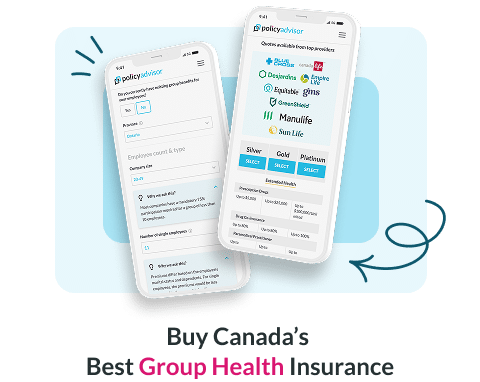- Employers are offering customizable group benefits with wellness and health spending accounts to meet diverse employee needs
- Expanded mental health coverage, virtual therapy, and stress-management perks are becoming standard in modern benefits plans
- Diversity Equity and Inclusion-driven benefits now include gender-affirming care, cultural leave, and fertility support to reflect diverse workforces
- AI tools, mobile portals, and virtual care access help employers streamline claims, personalize coverage, and engage remote teams
Employee wellbeing is no longer a perk—it’s a workplace priority. As expectations shift and employees demand more inclusive, personalized, and wellness-driven benefits, employers must rethink how their group insurance plans support physical, mental, and financial health. In fact, 89% of Canadians believe it’s important for employers to prioritize employee wellbeing. This makes employee benefits a clear benchmark for a competitive workplace culture.
In this blog, we explore why employee benefits matter in Canada, the key employee benefits trends shaping 2025, and how small businesses can adapt to these wellness-focused group health insurance plans for the Canadian workforce.
What are employee benefits in Canada?
Employee benefits in Canada are non-cash compensation provided by employers to enhance employee well-being, job satisfaction, and financial security. These benefits go beyond base salary and may include health coverage, retirement savings plans, paid leave, and wellness programs.
Offering a competitive employee benefits package helps Canadian employers attract and retain top talent, reduce absenteeism, and support a productive workforce.
Why do Canadian employers provide group benefits to employees?
Employers in Canada offer group benefits to attract skilled talent, support employee well-being, and stay competitive in the job market. Group insurance plans help reduce absenteeism, increase productivity, and strengthen employee loyalty.
- Attract top talent: Group benefits enhance the overall compensation package and help employers appeal to skilled professionals in a competitive Canadian job market
- Retain employees: A well-structured benefits plan increases employee satisfaction and reduces turnover by demonstrating long-term commitment to their well-being
- Support employee health: Access to extended health, dental, and mental health services helps employees manage their health proactively and reduces workplace disruption
- Lower absenteeism: Preventive care and early intervention reduce the frequency of sick days and the financial impact of long-term disability claims
- Improve productivity: Healthier, less-stressed employees are more focused, engaged, and efficient in their roles, directly impacting overall business performance
- Encourage financial wellness: Retirement and savings plans reduce financial stress and help employees plan for the future with greater confidence and stability
- Strengthen employer branding: Offering comprehensive group benefits signals that the company values its people and is committed to creating a supportive workplace culture
Top 7 employee benefits trends in Canada
In 2025, Canadian employee benefits are evolving rapidly to meet the expectations of a hybrid, multigenerational, and wellness-focused workforce. Some of the top employee benefits trends in Canada include mental health benefits, preventive care and chronic disease management, personalized spending accounts, AI-powered claims support, DEI-led benefits and more.
1. Personalized and flexible group benefits plans
Highly tailored group benefits plans
Employers are shifting away from one-size-fits-all plans by offering flexible group benefits that reflect individual employee needs, health status, family structures, and work styles.
Modular plans and Health/Wellness Spending Accounts
Modular benefits let employees build their own coverage from a plethora of benefits options. These plans are paired with Health and Wellness Spending Accounts. They can allocate pre-tax or taxable credits to therapy, massages, yoga classes, dental services, or even home office ergonomics.
Add‑ons for fertility, pet insurance, and lifestyle perks
Canadian wellness benefits plans are increasingly offering fertility treatments (IVF, egg/sperm freezing), surrogacy support, and adoption coverage. Pet insurance, legal services, nutritional counselling, and even identity theft protection are becoming valuable add-ons for millennial and Gen Z employees.
2. Holistic mental health and wellness support
Expanded mental health and wellbeing coverage
Mental health group benefits in Canada cover licensed psychologists, psychotherapists, and social workers under extended health plans. These benefits often come with increased annual maximums of $1,000–$5,000.
Expanded EAPs, virtual therapy, and wellness apps
EAPs offer 24/7 access to short-term counselling, crisis support, legal advice, and addiction services. Employers are also integrating app-based wellness solutions like Headspace, Calm, Inkblot, etc, into their benefit offerings.
Mental health parity in group insurance plans
Insurers are moving toward full parity between mental and physical health, meaning fewer exclusions and equal access across providers and specialties.
Stress‑management days, mental health PTO, and proactive care
Companies are introducing paid mental health days, stress reset leaves, mindfulness training, and mental health coaching to prevent burnout among their workforce.
3. Focus on preventive care and chronic condition management
Biometric screenings, health risk assessments, and gym perks
On-site or digital biometric tests (cholesterol, glucose, blood pressure) and health risk assessments help employees understand their baseline health. Benefits also include gym memberships, ClassPass subscriptions, or fitness device reimbursements.
Weight loss, diabetes reversal, and condition-specific coaching
Programs supporting sustainable weight loss, diabetes prevention or reversal (like Virta Health), thyroid management, and PCOS or menopause support are growing in popularity within group benefit plans.
Partnerships with digital wellness platforms and coaches
Employers are collaborating with platforms like League, TELUS Health, and Wellbeats to deliver personalized coaching in fitness, nutrition, sleep hygiene, and preventative care, both in-person and online.
4. Inclusive and sustainable benefit offerings
Diversity, Equity, and Inclusion (DEI)-focused benefits
Benefits now include gender-confirming surgeries, hormone therapy, and counselling for trans and non-binary employees. Culturally inclusive options such as additional religious holidays and indigenous traditional practices are being integrated into plans.
Inclusive family planning
Coverage for fertility treatments, gestational surrogacy, donor sperm/egg services, and adoption reimbursement helps employees of all identities and orientations build families on their terms.
Sustainability-driven perks
Environmental, Social and Governance (ESG)-aligned benefits now feature green commuting allowances (e-bike credits, transit passes), carbon offset options for business travel, and eco-friendly WSA categories like clean products and sustainable food subscriptions.
5. Tech-enabled solutions for hybrid and remote teams
Mobile-first benefits for hybrid and remote workers
Employers are adopting mobile apps and cloud-based dashboards that let employees access their benefits, submit claims, schedule appointments, and receive real-time plan updates from anywhere.
Remote-friendly medical care
Virtual primary care, mental health support, dermatology consults, and e-pharmacy delivery are standard offerings, ensuring access regardless of an employee’s physical location.
Flexible coverage for part-time, freelance, and gig workers
Portable, non-traditional benefit structures offer scaled-down but meaningful coverage (e.g. dental, therapy, life insurance) for contract, freelance, and part-time employees who are often excluded from traditional plans.
Cross-regional tax and compliance solutions
Plans are being designed with province-specific tax implications, OHIP coordination, and multi-region eligibility in mind, helping employers stay compliant while supporting distributed teams.
6. Financial wellness and elder care support
Student loan repayment, financial coaching, and education tools
Employers are offering direct student loan repayment assistance, access to robo-advisors, budgeting tools, RRSP education, and certified financial coaching to promote long-term financial stability.
Elder care support, caregiver leave, and coordination services
With a growing sandwich generation, employers are introducing caregiver leave policies, elder care navigation services, and digital tools to assist with appointment scheduling, long-term care planning, and financial decision-making.
7. AI-driven digital-first benefits administration
Predictive analytics, smart enrolment, and AI-powered claims
AI is transforming benefits by automating enrolment decisions, flagging usage trends, and accelerating claim approvals. Smart platforms recommend plan options based on life stage, family status, or claim history.
Mobile portals, self-service dashboards, and real-time tracking
Modern platforms allow employees to manage claims, review coverage, schedule services, and track reimbursements through intuitive mobile and web-based interfaces.
Can small businesses also offer advanced employee benefits trends?
Yes, small businesses in Canada can offer advanced employee benefits that reflect the latest evolving trends. Due to flexible plan designs, low-cost plans, and digital health tracking platforms, small employers can now compete with larger organizations in attracting and retaining talent.
Small businesses can also offer cost-effective solutions like Health and Wellness Spending Accounts, virtual care, mental health support, and even fertility or gender-affirming benefits. These are all scaled to their workforce size and budget. Many group insurance providers offer plans tailored for small businesses with as few as 2–5 employees.
With the rise of hybrid work, inclusive benefits, and AI-powered administration, small businesses can deliver modern, competitive, and compliant group insurance programs without overwhelming costs or complexity.
How do inclusive group benefits improve workplace culture in Canada?
Inclusive group benefits are a powerful tool for building a healthier, more equitable workplace culture in Canada. These employee benefits can help create a culturally diverse team by encouraging a stigma-free work culture. It will help in cultivating peer respect among colleagues and appreciating a diverse workforce.
- Promoting a culture of belonging: Employees who see their needs reflected in group benefits, like gender-affirming care or fertility support, feel valued, which boosts morale and fosters long-term commitment
- Creating space for open, stigma-free dialogue: Inclusive coverage encourages open conversations around mental health, family planning, and identity, reducing silence and shame in the workplace
- Embedding equity into organizational values: When underrepresented needs, such as menopause or mental health day-offs, are covered, it shows the company values fairness, which builds trust across diverse teams
- Normalizing different life experiences: Recognizing varied family structures, religious holidays, or transition-related leaves helps employees feel safe being themselves at work, reducing social friction
- Cultivating team empathy and peer respect: Exposure to diverse benefits options sparks awareness among coworkers, encouraging more empathetic, inclusive interactions within and across teams
- Strengthening retention through authentic inclusion: Employees are more likely to stay in workplaces where benefits match their lived realities, reinforcing a culture of loyalty, support, and inclusion
How can employers create the best wellness-focused group health insurance plan in Canada?
To build a successful wellness-focused group health insurance plan in Canada, employers must go beyond basic coverage. By understanding employee needs and integrating digital tools, they can create personalized, cost-effective plans that support total wellbeing.
- Using employee feedback to guide plan design: Conducting regular employee surveys helps identify specific health, mental wellness, and financial concerns so employers can offer benefits people actually use
- Choosing insurers with built-in wellness features: Employers can enhance their group health insurance by partnering with providers that offer mental health support, wellness coaching, and financial wellness programs
- Applying AI and data analytics for smarter benefits: Using digital platforms and analytics tools helps employers track benefits engagement, reduce costs, and personalize coverage based on real-time employee needs
How to get the best employee benefits quotes in Canada?
Getting the best employee benefits quotes in Canada starts with understanding your business needs and comparing plans from multiple insurers. Whether you’re a growing startup or an established company, finding affordable group benefits that offer real value can be challenging without expert guidance. That’s where PolicyAdvisor comes in!
Our trusted, licensed advisors work closely with you to compare quotes from over 30 of Canada’s top group insurance providers. This ensures that you find the most cost-effective solution for your small business, even if you have as few as two employees. We help tailor your employee benefits plan to match your budget and coverage goals, enabling you to secure the most affordable group benefits quotes.
Our advisors continue to support you after the purchase through our dedicated after-sales service. Schedule a call with us today to find the best employee benefits plan for your workforce!
Frequently asked questions
Can you customize workplace benefits plans in Canada?
Yes, employers in Canada can fully customize employee benefits plans to meet the specific needs of their workforce. Insurers offer modular plan designs, allowing employers to choose from options like extended health, dental, vision, mental health, and wellness spending accounts.
Small businesses can also add features such as virtual care, fertility coverage, or financial wellness programs. This flexibility helps employers align their group benefits with workforce demographics, budget constraints, and organizational goals.
Should group health insurance plans be revised every year?
Yes, it’s a best practice for employers to review and revise their group health insurance plans annually. Regular reviews help ensure the plan remains relevant, competitive, and cost-effective. As employee needs, workforce demographics, or insurer offerings change, updating coverage allows employers to address emerging wellness trends and maintain employee satisfaction.
Annual renewals also allow businesses to renegotiate premiums, evaluate claims data, and add or remove coverage options based on usage and feedback.
How much does group health insurance cost for small businesses?
Group health insurance costs for small businesses in Canada vary based on plan design, company size, employee age, and location. On average, employers can expect to pay between $100 – $300 per employee per month. However, flexible options like Health Spending Accounts or modular coverage can lower costs while still offering value.
Can employees track claim status in real time for group medical insurance?
Yes, most modern group medical insurance providers in Canada offer digital platforms or mobile apps. These apps allow employees to track claim status in real time. These user-friendly tools provide instant access to submitted claims, reimbursement details, and remaining coverage limits.
Some platforms also offer paperless claims submission, direct deposit options, and AI-powered support for faster, more accurate processing.
How long does it take to implement group benefits in Canada?
In Canada, implementing group benefits typically takes 2 to 4 weeks, though the exact timeline depends on the insurance provider and the complexity of the plan.
The process involves selecting coverage options, gathering employee information, completing applications, and setting up administrative systems. Larger organizations or plans with customized features may take longer due to additional underwriting and approvals.
Group benefits in Canada are evolving to prioritize holistic employee wellbeing. In 2025, the top employee benefits trends include modular group plans, flexible wellness and health spending accounts, and expanded coverage for mental health, fertility, and pet care. Employers are integrating virtual therapy, DEI-focused benefits like gender-affirming care, and tech-enabled claims platforms. There’s a growing focus on preventive care, AI-powered personalization, and inclusive support for gig, remote, and part-time workers. These trends reflect a shift toward employee-centric, data-driven group benefits that foster retention, engagement, and workplace culture
The State of Health and Wellness in Canada | 2024. Environics Research, 2024





